The Long Journey of ICARUS: From the LAr-TPC Concept to the First Full-Scale Detector
Abstract
1. Introduction
2. LAr-TPC: First Concepts
3. The First Working ICARUS Prototypes
- Liquid argon purification. This was ensured by using clean and non de-gassing materials for all inner instrumentation like feed-throughs flanges, cables, holders, etc. Feed-throughs had to be tight to avoid leaks between the clean argon and the outside.
- Wire chambers. The mechanics of the inner TPC had to grant a high precision, providing a non-destructive readout with different wire planes and a wire pitch of few millimeters, to be made unaffected by the thermal stress when going from room to cryogenic temperature.
- Electronics. The development of a low noise amplifier was necessary to obtain a good signal-to-noise ratio, given the absence of amplification inside the liquid argon.
- Software. A brand new software infrastructure, data management and reduction and track reconstruction algorithms were developed to cope with the large number of 3D digitized images.
4. ICARUS T600 Pavia Surface Run
5. ICARUS T600 Operations at LNGS
- Drift electron lifetime. This was measured continuously and with high precision, using the residual cosmic rays crossing the detector at the rate of ∼3100 muons per day [34]. The lifetime was measured to be around 7 ms, corresponding to 40 ppt (O equivalent) for most of the time, resulting in a 12% maximum charge attenuation. Moreover, at the end of the ICARUS physics run in 2013, a new re-circulation pump allowed to obtain the record electron lifetime of 15 ms, corresponding to ∼20 ppt.
- Multiple scattering. An innovative algorithm to measure the effect of the Multiple Coulomb Scattering (MCS) for charged-current muons exiting the detector was developed. It was validated with ∼400 muons produced in CNGS neutrino interactions in the rock upstream the Hall B and stopping inside the LAr active volume. The ability to measure the stopping muon momentum also through calorimetry (-dE/dx) allowed to have a benchmark for the MCS measurements, providing a momentum resolution p/p ∼ 15% in the few-GeV energy range [35].
- Atmospheric neutrino detection. Atmospheric neutrinos were identified in ICARUS-T600 by inspecting the cosmic ray data collected with an overall exposure of 0.73 kton year, where ∼200 atmospheric neutrino events were expected. These kind of events, where selected using new methods for the automatic identification of the neutrinos, needed to filter out the overcoming cosmic tracks. Apart from the interest of the search itself, these methods demonstrated that automatic tools might be used to identify neutrinos having energies similar to the one expected from the Fermilab neutrino beams, in view of the following Short-Baseline Neutrino (SBN) program. The time needed for a visual event identification was effectively reduced, allowing to identify both CC and CC candidates [36]. An example of downward-going quasi elastic CC event is shown in Figure 9.
- Search for LSND-like events in CNGS. One of the major features of the ICARUS-T600 as a LAr-TPC, which makes this technology highly competitive with the Ring Water Cherenkov detectors for neutrino searches, is the capability in the electron/photon separation through the measurement of the energy loss in the very first centimeters of the e.m. shower, which is developing in a liquid argon medium with a radiation length of ∼18 cm. In general, this allows a LAr-TPC to effectively reject the neutral current background to events. This feature was successfully applied to a sample of electron neutrinos collected in coincidence with the CNGS muon neutrino beam, where a small intrinsic contamination of was expected. The measurement was motivated by the possibility to search for anomalous → oscillations, hinting to the existence of sterile neutrino states, as reported by a number of past and present experiments at the accelerators like LSND [37] and MiniBooNE [38], and recently investigated by the MicroBooNE LAr-TPC [39]. Seven events were identified in ICARUS-T600 as CC candidates, in agreement with the 8.5 ± 1.1 events expected from the intrinsic CNGS beam component and a standard framework of three flavor mixing. ICARUS-T600 then provided a limit on the oscillation probability P(→) ≤ 3.86 × 10 at 90% CL [40,41], whose effect on the oscillation parameter space is shown in Figure 10. One of the seven CC candidates is shown in Figure 11 (top): the evolution from the single m.i.p. CC electron to the e.m. shower is evident by looking at the energy loss in the individual wires, see Figure 11 (bottom).
6. ICARUS at Fermilab within the SBN Project
- A layer of 2.85 m concrete overburden placed on top of the detector to remove all primary photons and to effectively reduce the neutron background by a factor ∼200. The muon component is reduced by the overburden by ∼25%;
- A ∼4 segmented Cosmic Ray Tagging (CRT) detector surrounding ICARUS-T600, composed by two layers of plastic scintillators arranged in XY configuration, with a total surface of ∼1100 m. The CRT is expected to tag about 95% of cosmic muons entering in the detector;
- A brand new LAr VUV scintillation light detection system, made of 90 Hamamatsu R5912-MOD (8”) PMTs in each TPC [47,48], see Figure 13 (left). This system is characterized by a ∼1 ns time resolution and a detection capability of very low energy events, below 100 MeV, being effective in tagging neutrino events in coincidence with the beam spill, while rejecting the cosmic ray events occurring out of time. PMTs are equalized in gain and calibrated in time by using a dedicated laser system illuminating the PMT windows through an optical fiber [49];
- New TPC electronics, designed and optimized for the ICARUS-T600 shallow depths operations, with an improvement of the performance of the system in terms of signal-to-noise ratio. The integration of advanced electronic components also allowed to reduce costs and volumes with respect to the LNGS configuration [50,51].
7. Conclusions
Funding
Conflicts of Interest
References
- Rubbia, C. The Liquid-Argon Time Projection Chamber: A New Concept for Neutrino Detector, CERN-EP-77-08 (1977). Available online: https://cds.cern.ch/record/117852/files/CERN-EP-INT-77-8.pdf (accessed on 15 November 2022).
- Huffman, W.A.; Losecco, J.M.; Rubbia, C. Recent Results in the Development of Liquid Argon Imaging Chambers. IEEE Trans. Nucl. Sci. 1979, 64, NS-26. [Google Scholar] [CrossRef]
- Chen, H.H.; Lathrop, J.F. Observation of ionization electrons drifting large distances in liquid argon. Nucl. Instr. Meth. 1978, 150, 585. [Google Scholar] [CrossRef]
- Chen, H.H.; Doe, P.J. Long Distance Drifting of Ionization Electrons in Liquid Argon. IEEE Trans. Nucl. Sci. 1981, 454, NS-28. [Google Scholar] [CrossRef]
- Doe, P.J.; Mahler, H.J.; Chen, H.H. Observation of Tracks in a Two-dimensional Liquid Argon Time Projection Chamber. Nucl. Instr. Meth. 1982, 199, 639. [Google Scholar] [CrossRef]
- ICARUS Collaboration (ICARUS). A Proposal for the Gran Sasso Laboratory, INFN/AE-85/7 Frascati 1985. Available online: https://www.lnf.infn.it/sis/preprint/getfilepdf.php?filename=INFN-AE_85-7.pdf (accessed on 15 November 2022).
- Buckley, E. et al. [ICARUS Collaboration] A study of ionization electrons drifting large distances in liquid argon. Nucl. Instr. Meth. 1989, A275, 364. [Google Scholar] [CrossRef]
- Bonetti, E. et al. [ICARUS Collaboration] A study of the electron image due to ionizing events in a two-dimensional liquid argon TPC with a 24 cm drift gap. Nucl. Instr. Meth. 1990, A286, 135. [Google Scholar] [CrossRef]
- Bettini, A. et al. [ICARUS Collaboration] A Study of the factors affecting the electron lifetime in ultrapure liquid argon. Nucl. Instr. Meth. 1991, A305, 177. [Google Scholar] [CrossRef]
- Miyajima, M.; Takahashi, T.; Konno, S.; Hamada, T.; Kubota, S.; Shibamura, E.; Doke, T. Average energy expended per ion pair in liquid argon. Phys. Rev. 1974, A9, 1438. [Google Scholar] [CrossRef]
- Shibamura, E.; Hitachi, A.; Doke, T.; Takahashi, T.; Kubota, S.; Miyajima, M. Drift velocities of electrons, saturation characteristics of ionization and W-values for conversion electrons in liquid argon, liquid argon-gas mixtures and liquid xenon. Nucl. Instr. Meth. 1975, 131, 249. [Google Scholar] [CrossRef]
- Aprile, E.; Ku, W.H.M.; Park, J.; Schwartz, H. Energy resolution studies of liquid argon ionization detectors. Nucl. Instr. Meth. 1987, A261, 519. [Google Scholar] [CrossRef]
- Benetti, P. et al. [ICARUS Collaboration] A three-ton liquid Argon time projection chamber. Nucl. Instrum. Meth. 1993, A332, 395. [Google Scholar] [CrossRef]
- Cennini, P. et al. [ICARUS Collaboration] Performance of a three-ton liquid Argon time projection chamber. Nucl. Instr. Meth. 1994, A345, 230. [Google Scholar] [CrossRef]
- Arneodo, F. et al. [ICARUS Collaboration] The ICARUS 50 l LAr TPC in the CERN Nu Beam. arXiv 1998, arXiv:hep-ex/9812006v1. [Google Scholar]
- Eskut, E. et al. [CHORUS Collaboration] The CHORUS experiment to search for νμ→ντ oscillation. Nucl. Instr. Meth. 1997, A401, 7. [Google Scholar] [CrossRef]
- Altegoer, J. et al. [NOMAD Collaboration] The NOMAD experiment at the CERN SPS. Nucl. Instr. Meth. 1998, A404, 96. [Google Scholar] [CrossRef]
- Arneodo, F. et al. [ICARUS Collaboration] Performance of the 10 m3 ICARUS liquid argon prototype. Nucl. Inst. Meth. 2003, A498, 292. [Google Scholar] [CrossRef]
- Cennini, P. et al. [ICARUS Collaboration] Detection of scintillation light in coincidence with ionizing tracks in a liquid argon time projection chamber. Nucl. Inst. Meth. 1999, A432, 240. [Google Scholar] [CrossRef]
- Amerio, S. et al. [ICARUS Collaboration] Design, construction and tests of the ICARUS T600 detector. Nucl. Instr. Meth. 2004, A527, 329. [Google Scholar] [CrossRef]
- Amoruso, S. et al. [ICARUS Collaboration] Analysis of the liquid argon purity in the ICARUS T600 TPC. Nucl. Instr. Meth. 2004, A516, 68. [Google Scholar] [CrossRef]
- Amoruso, S. et al. [ICARUS Collaboration] Study of electron recombination in liquid argon with the ICARUS TPC. Nucl. Instr. Meth. 2004, A523, 275. [Google Scholar] [CrossRef]
- Ankowski, A. et al. [ICARUS Collaboration] Characterization of ETL 9357FLA photomultiplier tubes for cryogenic temperature applications. Nucl. Instr. Meth. 2006, A556, 146. [Google Scholar] [CrossRef]
- Amoruso, S. et al. [ICARUS Collaboration] Measurement of the μ decay spectrum with the ICARUS liquid argon TPC. Eur. Phys. J. 2004, C33, 233. [Google Scholar]
- Ankowski, A. et al. [ICARUS Collaboration] Measurement of though-going particle momentum by means of multiple scattering with the ICARUS T600 TPC. Eur. Phys. J. 2006, C48, 667. [Google Scholar] [CrossRef]
- Ankowski, A. et al. [ICARUS Collaboration] Energy Reconstruction of Electromagnetic Showers from π0 Decays with the ICARUS T600 Liquid Argon TPC. Acta Phys. Pol. 2010, B41, 103. [Google Scholar]
- Antonello, M. et al. [ICARUS Collaboration] Study of space charge in the ICARUS T600 detector. JINST 2020, 15, P07001. [Google Scholar] [CrossRef]
- Antonello, M. et al. [ICARUS Collaboration] Operation and performance of the ICARUS T600 cryogenic plant at Gran Sasso underground Laboratory. JINST 2015, 10, P12004. [Google Scholar] [CrossRef]
- Antonello, M. et al. [ICARUS Collaboration] Underground operation of the ICARUS T600 LAr-TPC: First results. JINST 2011, 6, P07011. [Google Scholar]
- Antonello, M. et al. [ICARUS Collaboration] The trigger system of the ICARUS experiment for the CNGS beam. JINST 2014, 9, P08003. [Google Scholar] [CrossRef]
- Antonello, M. et al. [ICARUS Collaboration] Measurement of the neutrino velocity with the ICARUS detector at the CNGS beam. Phys. Lett. 2012, B713, 17. [Google Scholar] [CrossRef]
- Antonello, M. et al. [ICARUS Collaboration] Precision measurement of the neutrino velocity with the ICARUS detector in the CNGS beam. J. High Energy Phys. 2012, 49, 112012. [Google Scholar]
- Antonello, M. et al. [ICARUS Collaboration] A search for the analogue to Cherenkov radiation by high energy neutrinos at superluminal speeds in ICARUS. Phys. Lett. 2012, B711, 270. [Google Scholar] [CrossRef]
- Antonello, M. et al. [ICARUS Collaboration] Experimental observation of an extremely high electron lifetime with the ICARUS-T600 LAr-TPC. JINST 2014, 12, P12006. [Google Scholar] [CrossRef]
- Antonello, M. et al. [ICARUS Collaboration] Muon momentum measurement in ICARUS-T600 LAr-TPC via multiple scattering in few-GeV range. JINST 2017, 12, P04010. [Google Scholar] [CrossRef]
- Farnese, C. [ICARUS Collaboration]. Atmospheric Neutrino Search in the ICARUS T600 Detector. Universe 2019, 5, 17. [Google Scholar] [CrossRef]
- Aguillar, A. et al. [LSND Collaboration] Evidence for neutrino oscillations from the observation of appearance in a beam. Phys. Rev. 2001, D64, 112007. [Google Scholar]
- Aguilar-Arevalo, A. et al. [MiniBooNE Collaboration] Improved Search for → Oscillations in the MiniBooNE Experiment. Phys. Rev. Lett. 2013, 110, 161801. [Google Scholar] [CrossRef]
- Abratenko, P. et al. [MicroBooNE Collaboration] First constraints on light sterile neutrino oscillations from combined appearance and disappearance searches with the MicroBooNE detector. arXiv 2022, arXiv:2210.10216v3. [Google Scholar]
- Antonello, M. et al. [ICARUS Collaboration] Experimental search for the “LSND anomaly” with the ICARUS detector in the CNGS neutrino beam. Eur. Phys. J. 2013, C73, 2345. [Google Scholar] [CrossRef]
- Antonello, M. et al. [ICARUS Collaboration] Search for anomalies in the νe appearance from a νμ beam. Eur. Phys. J. 2013, C73, 2599. [Google Scholar] [CrossRef]
- Abi, B. et al. [DUNE Collaboration] Long-baseline neutrino oscillation physics potential of the DUNE experiment. Eur. Phys. J. 2020, C80, 978. [Google Scholar] [CrossRef]
- Acciarri, R.; Adams, C.; An, R.; Andreopoulos, C.; Ankowski, A.M.; Antonello, M.; Asaadi, J.; Badgett, W.; Bagby, L.; Baibussinov, B.; et al. A Proposal for a Three Detector Short-Baseline Neutrino Oscillation Program in the Fermilab Booster Neutrino Beam. arXiv 2015, arXiv:1503.01520v1. [Google Scholar]
- Aguilar-Arevalo, A.A. et al. [MiniBooNE Collaboration] The Neutrino Flux prediction at MiniBooNE. Phys. Rev. 2009, D79, 072002. [Google Scholar]
- Adamson, P.; Anderson, K.; Andrews, M.; Andrews, R.; Anghel, I.; Augustine, D.; Aurisano, A.; Avvakumov, S.; Ayres, D.S.; Baller, B.; et al. The NuMI neutrino beam. Nucl. Instr. Meth. 2016, A806, 279. [Google Scholar] [CrossRef]
- Serebrov, A.P. et al. [Neutrino-4 Collaboration] Search for sterile neutrinos with the Neutrino-4 experiment and measurement results. Phys. Rev. 2021, D104, 032003. [Google Scholar]
- Babicz, M.; Bagby, L.; Baibussinov, B.; Bellini, V.; Bonesini, M.; Braggiotti, A.; Centro, S.; Cervi, T.; Cocco, A.G.; Falcone, A.; et al. Test and characterization of 400 Hamamatsu R5912-MOD photomultiplier tubes for the ICARUS T600 detector. JINST 2018, 13, P10030. [Google Scholar] [CrossRef]
- Ali-Mohammadzadeh, B.; Babicz, M.; Badgett, W.; Bagby, L.; Bellini, V.; Benocci, R.; Bonesini, M.; Braggiotti, A.; Centro, S.; Chatterjee, A.; et al. Design and implementation of the new scintillation light detection system of ICARUS T600. JINST 2020, 15, T10007. [Google Scholar] [CrossRef]
- Bonesini, M.; Benocci, R.; Bertoni, R.; Falcone, A.; Mazza, R.; Torti, M.; Menegolli, A.; Raselli, G.L.; Rossella, M. The laser diode calibration system of the ICARUS T600 detector at FNAL. JINST 2020, 15, C05042. [Google Scholar] [CrossRef]
- Bagby, L.; Baibussinov, B.; Bellini, V.; Bonesini, M.; Braggiotti, A.; Castellani, L.; Centro, S.; Cervi, T.; Cocco, A.G.; Fabris, F.; et al. New read-out electronics for ICARUS-T600 liquid Argon TPC. Description, simulation and tests of the new front-end and ADC system. JINST 2018, 13, P12007. [Google Scholar] [CrossRef]
- Bagby, L.; Baibussinov, B.; Behera, B.; Bellini, V.; Benocci, R.; Betancourt, M.; Bettini, M.; Bonesini, M.; Boone, T.; Braggiotti, A.; et al. Overhaul and installation of the ICARUS-T600 liquid argon TPC electronics for the FNAL Short Baseline Neutrino program. JINST 2021, 16, P10307. [Google Scholar] [CrossRef]
- Farnese, C.; Fava, A.; Guglielmi, A.; Menegolli, A.; Meng, G.; Petrillo, G.; Prata, M.C.; Raselli, G.L.; Rossella, M.; Scarpelli, A.; et al. Implementation of the trigger system of the ICARUS-T600 detector at Fermilab. Nucl. Instr. Meth. 2023, A1045, 167498. [Google Scholar] [CrossRef]
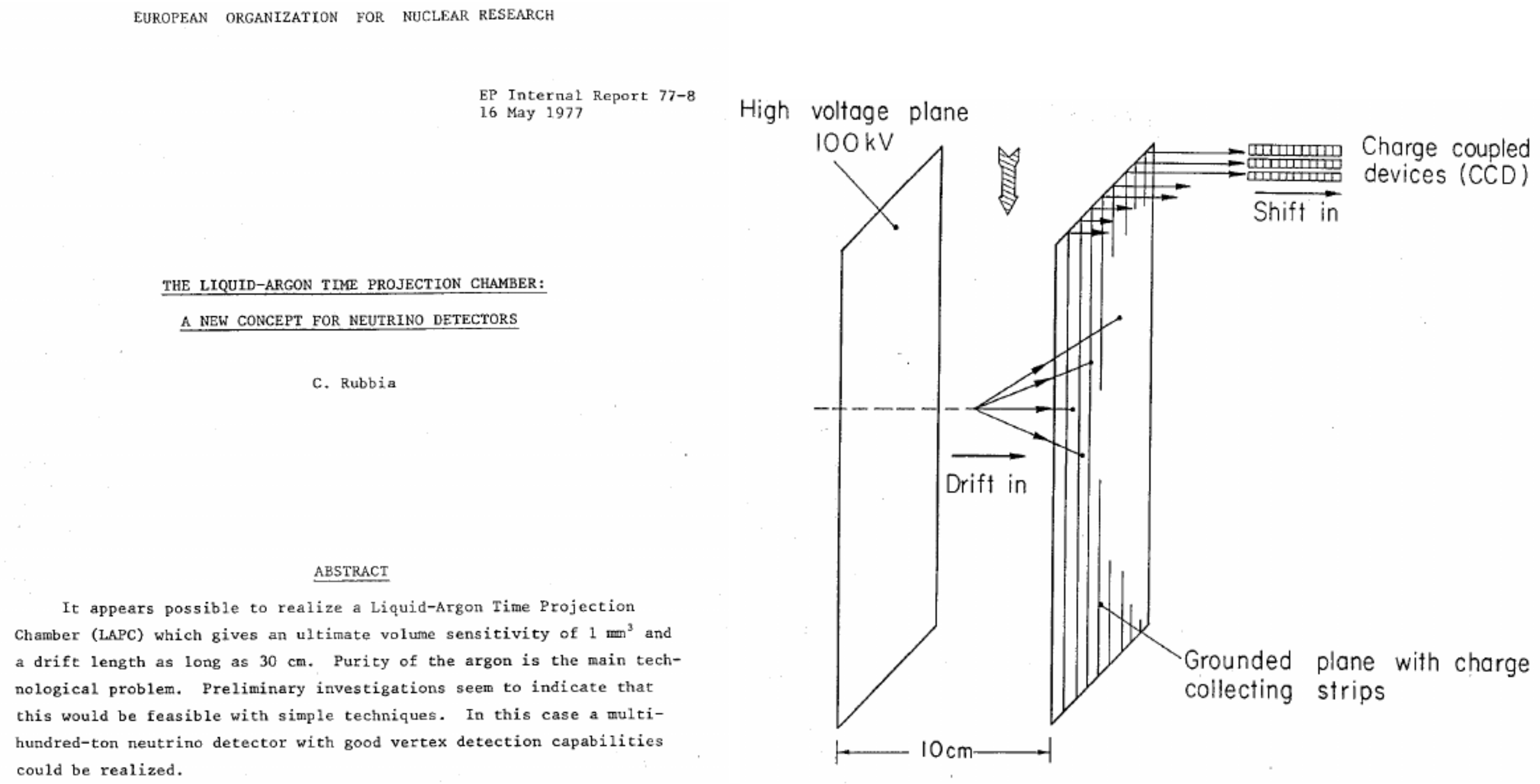

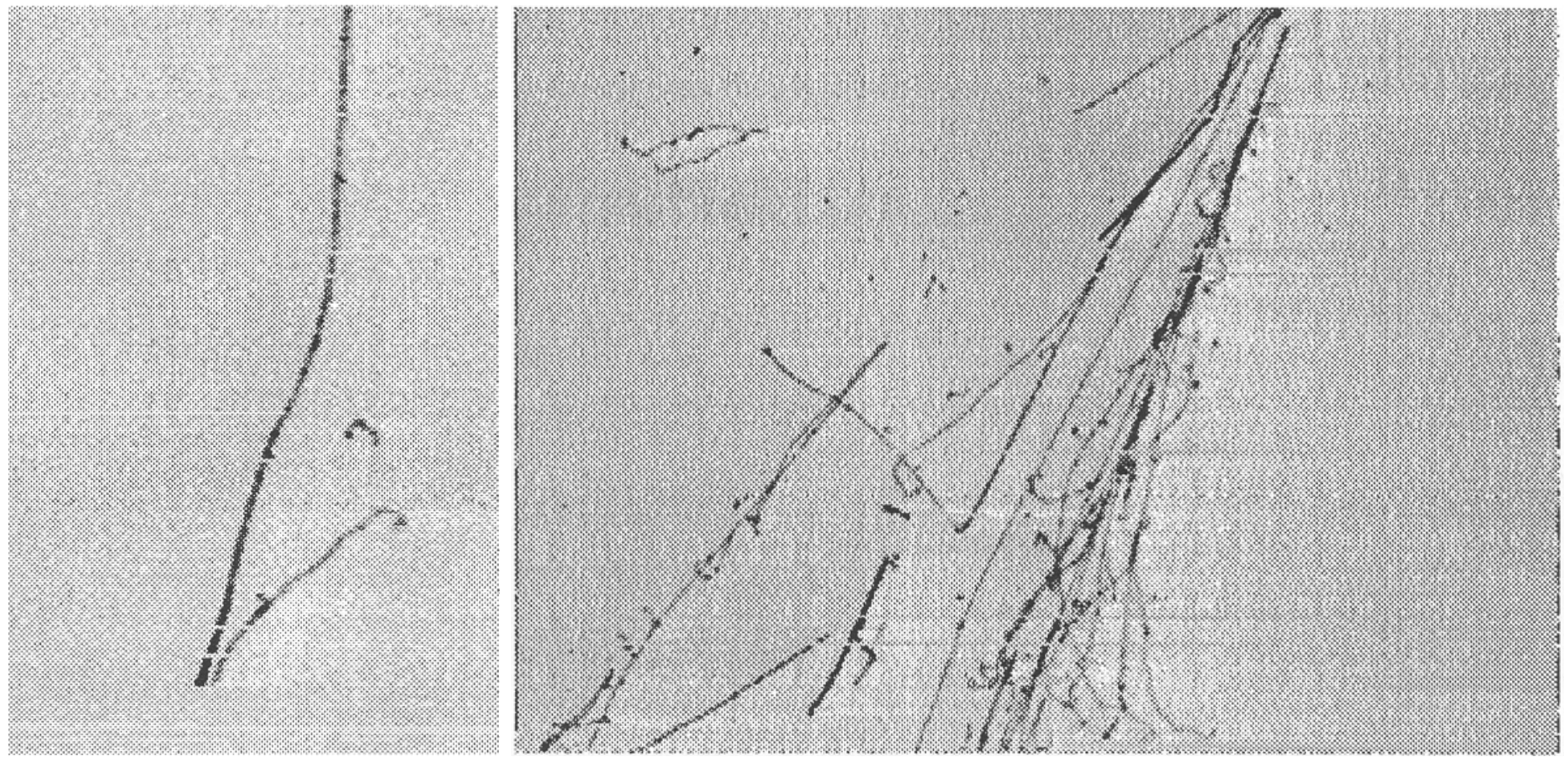
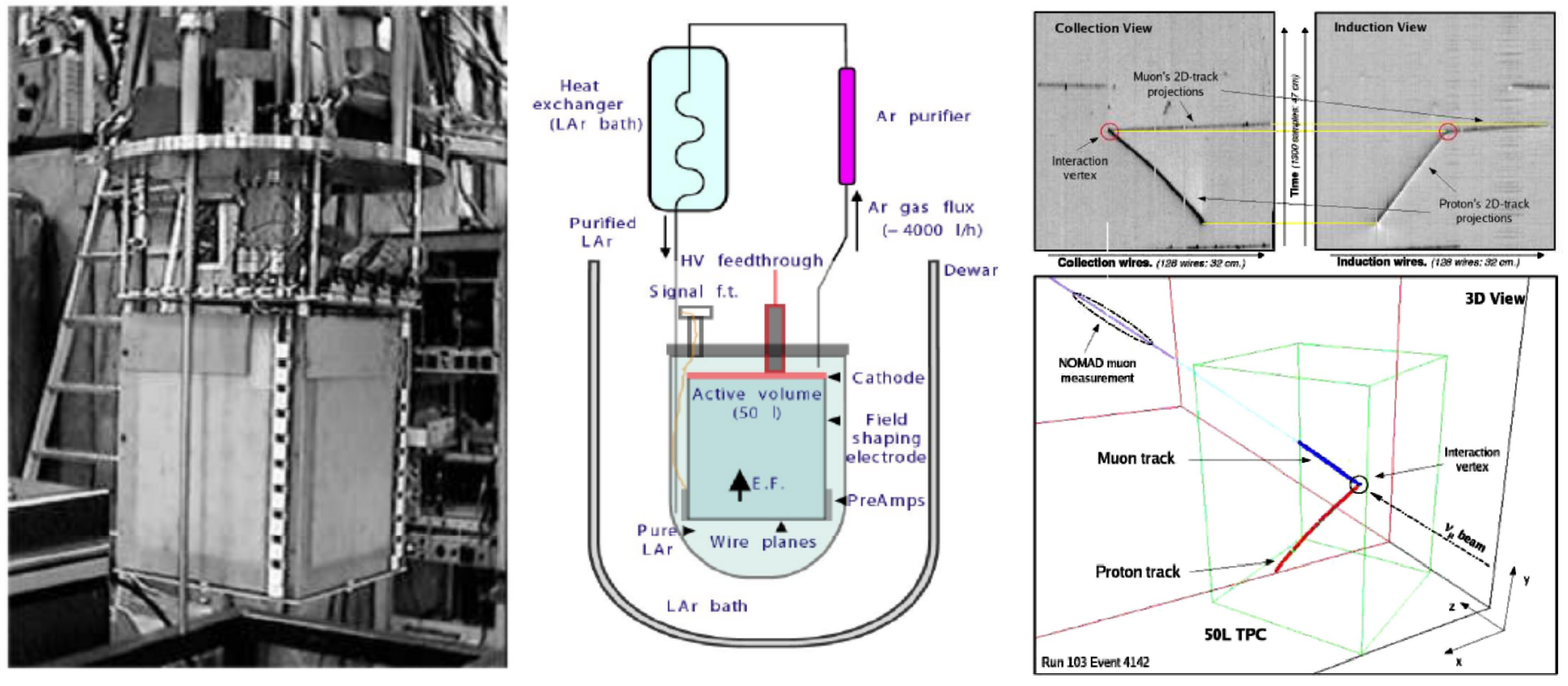
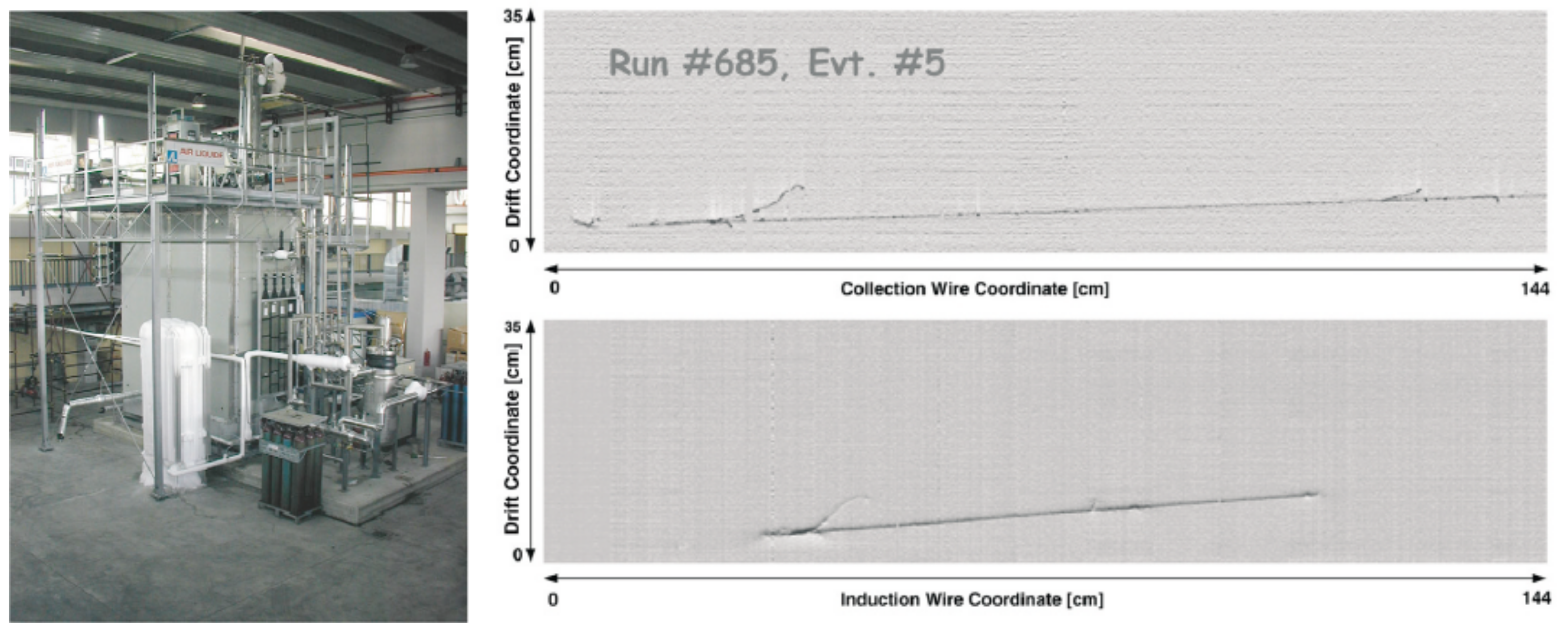

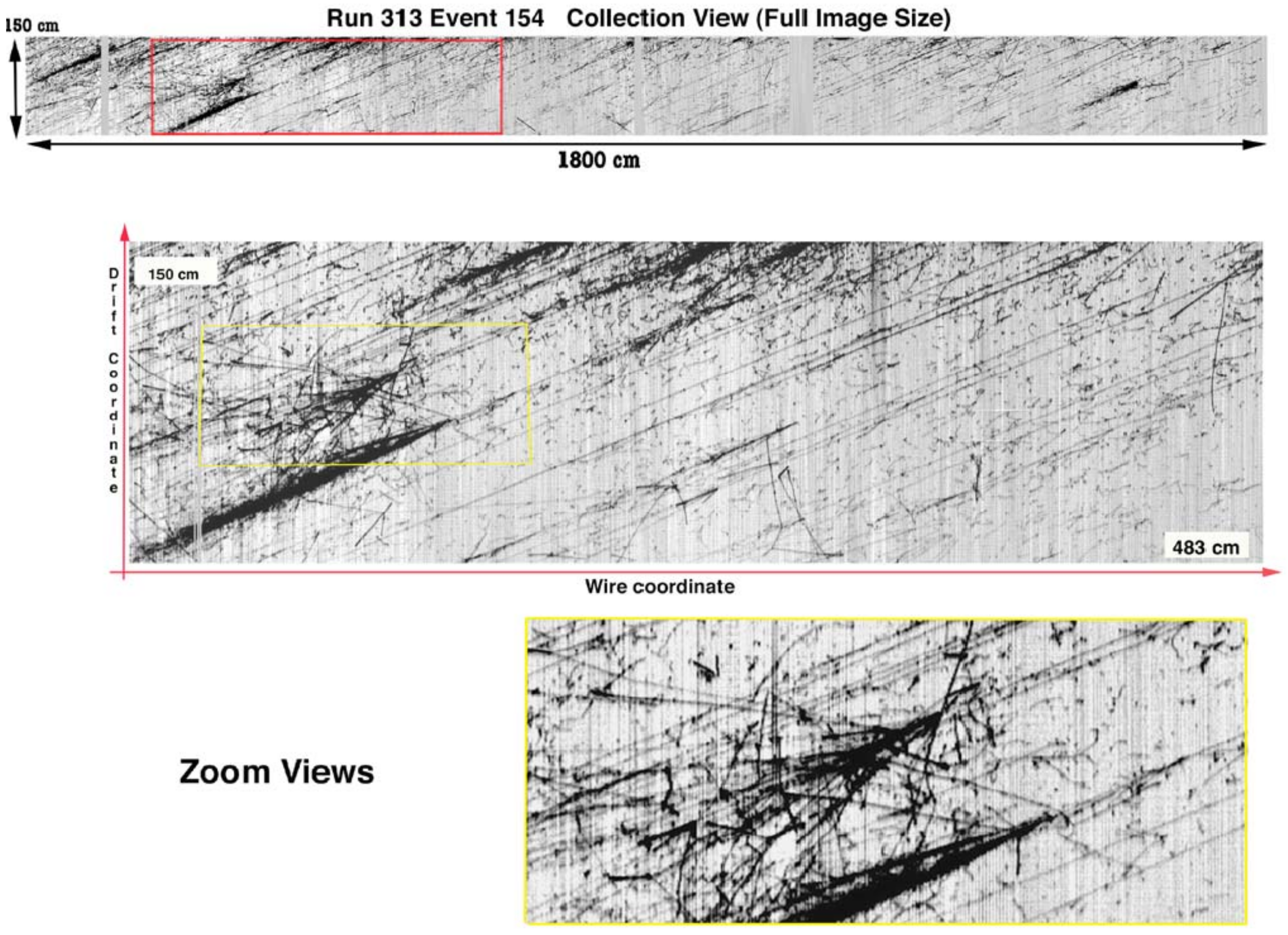
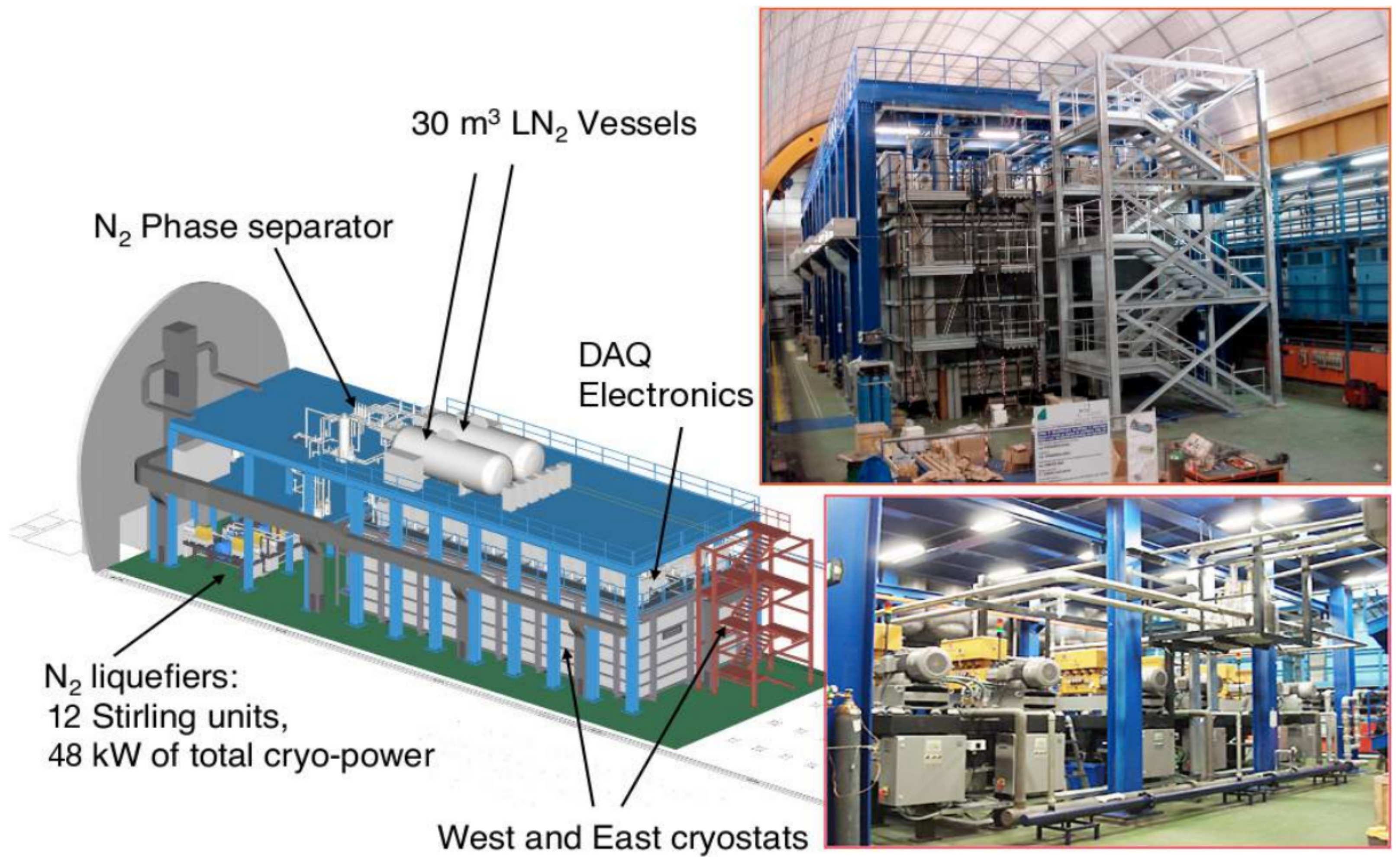
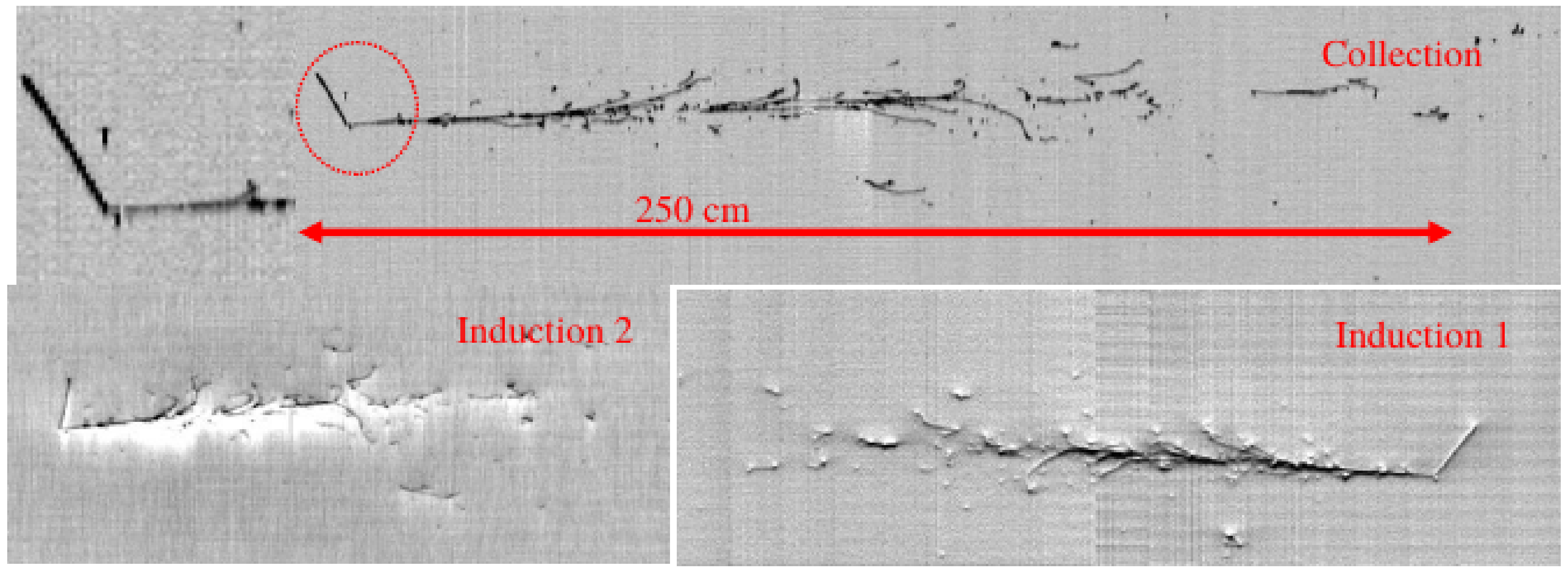
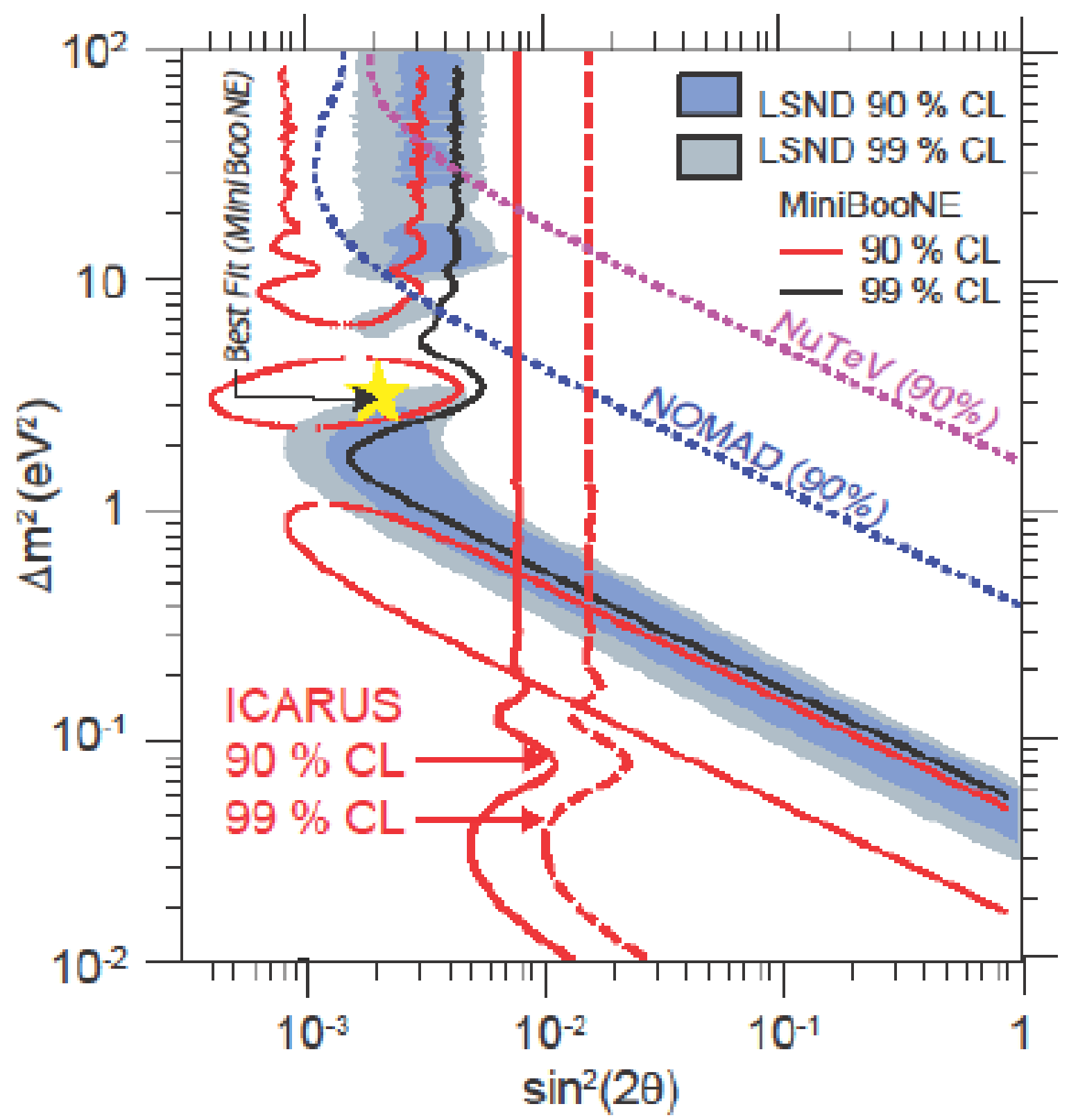
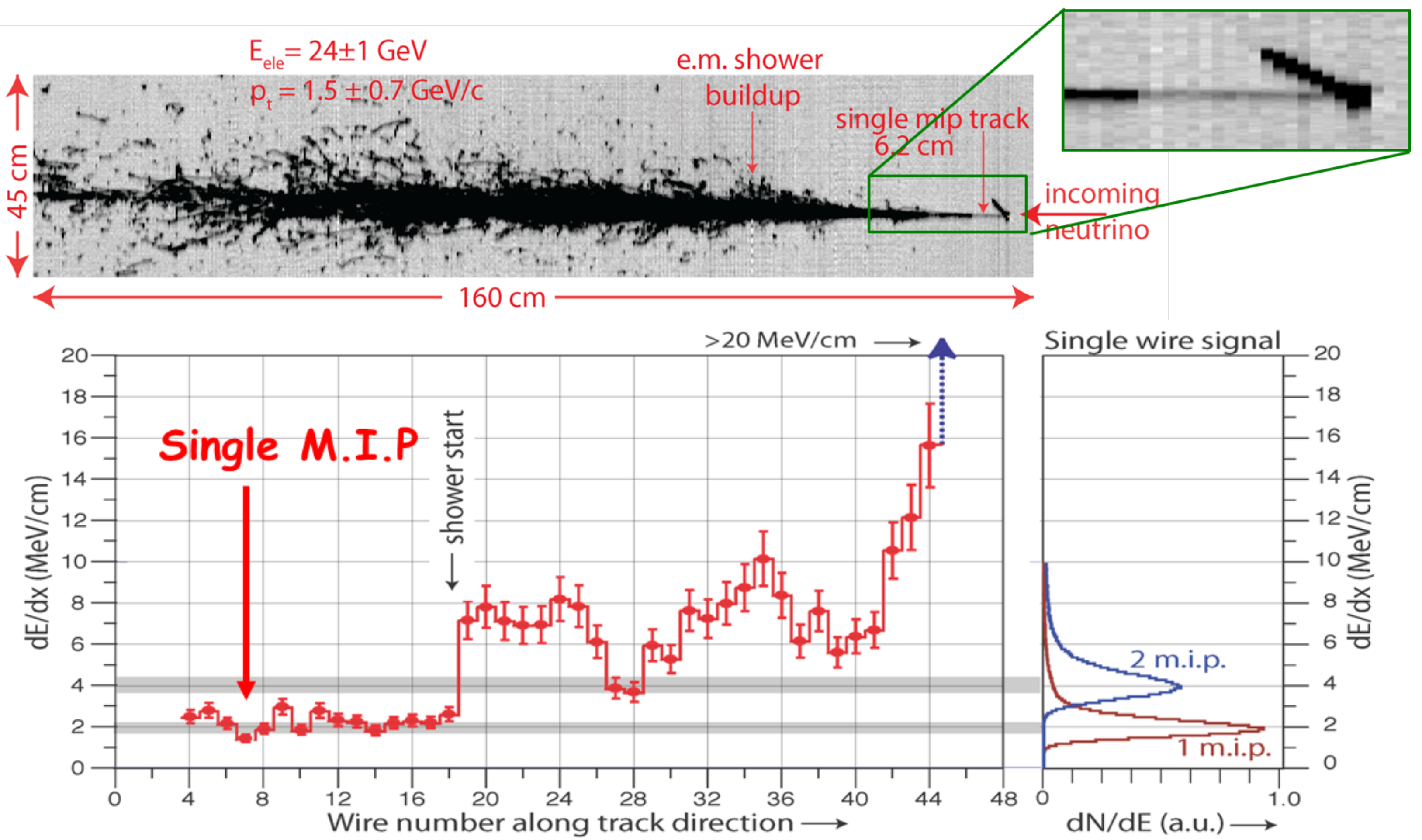

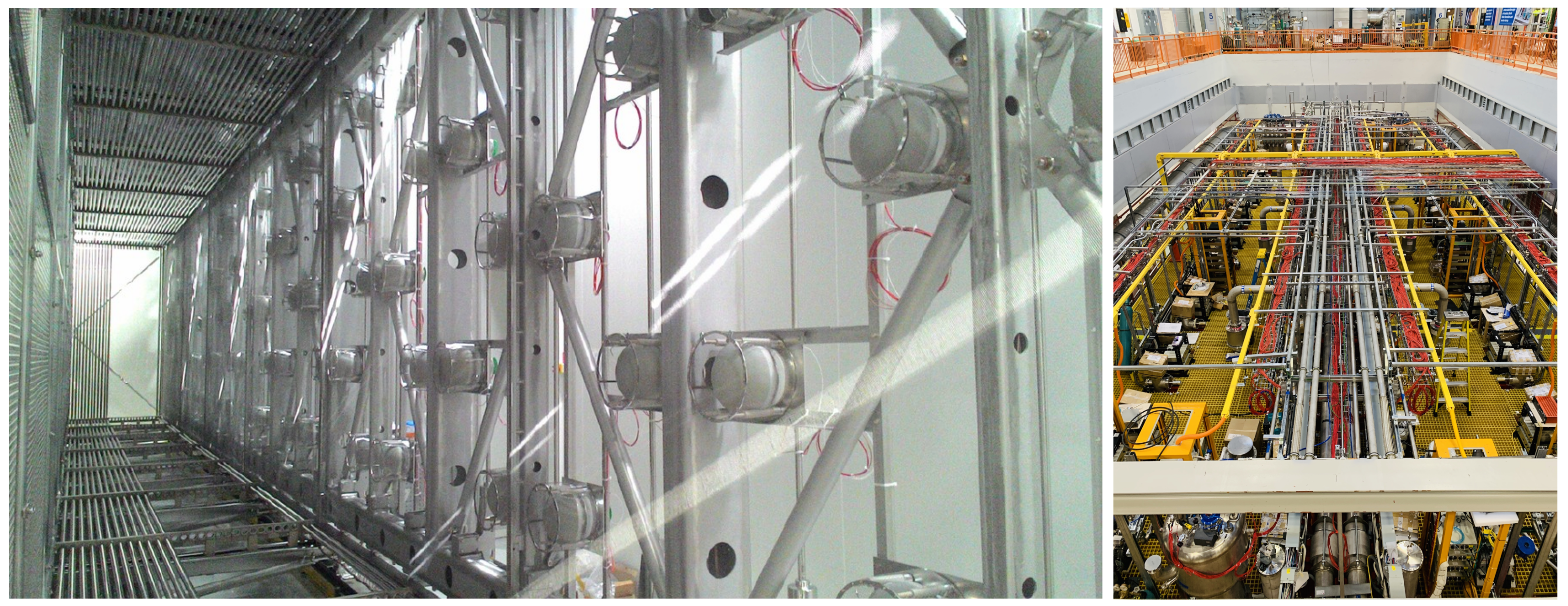

Disclaimer/Publisher’s Note: The statements, opinions and data contained in all publications are solely those of the individual author(s) and contributor(s) and not of MDPI and/or the editor(s). MDPI and/or the editor(s) disclaim responsibility for any injury to people or property resulting from any ideas, methods, instructions or products referred to in the content. |
© 2023 by the author. Licensee MDPI, Basel, Switzerland. This article is an open access article distributed under the terms and conditions of the Creative Commons Attribution (CC BY) license (https://creativecommons.org/licenses/by/4.0/).
Share and Cite
Menegolli, A. The Long Journey of ICARUS: From the LAr-TPC Concept to the First Full-Scale Detector. Universe 2023, 9, 74. https://doi.org/10.3390/universe9020074
Menegolli A. The Long Journey of ICARUS: From the LAr-TPC Concept to the First Full-Scale Detector. Universe. 2023; 9(2):74. https://doi.org/10.3390/universe9020074
Chicago/Turabian StyleMenegolli, Alessandro. 2023. "The Long Journey of ICARUS: From the LAr-TPC Concept to the First Full-Scale Detector" Universe 9, no. 2: 74. https://doi.org/10.3390/universe9020074
APA StyleMenegolli, A. (2023). The Long Journey of ICARUS: From the LAr-TPC Concept to the First Full-Scale Detector. Universe, 9(2), 74. https://doi.org/10.3390/universe9020074





